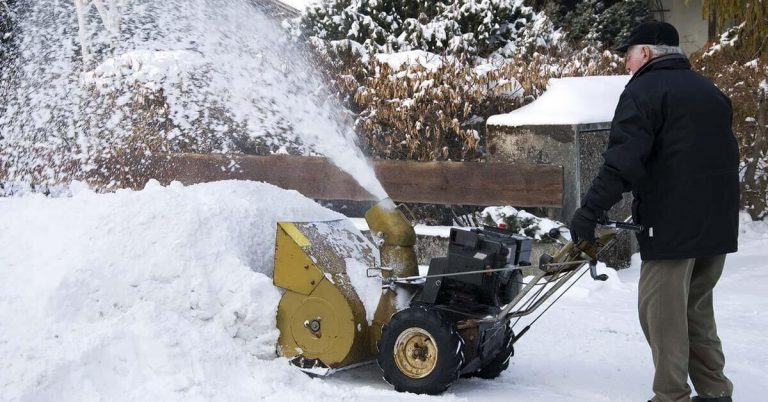If you’re older or have a history of heart disease, shoveling snow can be deadly.
First of all, the work is strenuous. Even worse, you’re out in the cold, which can increase both your heart rate and blood pressure. Add to all that the fact that most of us are less active in general in winter, so we’re not exactly in the best shape to begin with.
Let’s look at the numbers: A 2011 study done by the Research Institute at Nationwide Children’s Hospital and The Ohio State University College of Medicine analyzed data from emergency departments throughout a 17-year period.
During that time, about 195,000 people were treated for snow shoveling-related injuries. The vast majority suffered slip-related injuries. However, seven percent of patients were seen for cardiac events, resulting in 1,647 deaths.
Precautions to Take while Shoveling Snow
Let’s make one issue clear: Doctors say if you have any sort of heart condition at all, you simply should not shovel snow. Seniors, especially those at risk of slips and falls, shouldn’t try to remove snow manually, either. The risk for heart attack or another unfortunate accident is too high. If you fall under either of those categories, you’re better off hiring a neighborhood teen or a snow removal service.
Even if your heart is healthy and you engage in regular exercise, you should still take precautions to ensure your safety:
- Dress in appropriate layers. Ideally, you should wear layers to adjust for the outside temperature but not so many as to make movement difficult. Dress warmly and cover your face, head, and hands, especially if you’ll be outside for a long period of time. As for shoes, wearing waterproof boots with good traction can help you avoid falling on slick snow or ice.
- Push the snow. The number-one mistake people make when snow shoveling is to try and lift heavy loads. If you push the snow, it’s easier to move. Also, shovel your driveway in the shortest direction. If you do need to lift the snow, be sure to use your legs—not your back. Separating your hands on the shovel will also give you more leverage as you move the snow.
- Use a small shovel. You might be tempted to use a wide shovel to try and move more snow at once, but it’s better to move smaller loads throughout time. Since a shovel full of snow can weigh up to 15 pounds, creating lighter loads of snow will lessen the strain on your back and arms.
- Shovel frequently. Instead of waiting for the snow to finish falling, try to go out and shovel no more than two inches of accumulation at one time. This will make shoveling more manageable.
- Set time limits. Take a break after 20 or 30 minutes. Shoveling snow is hard, after all!
- Shovel with a partner. Never go out to shovel without letting someone else know. If you do get into trouble, someone will know to check on you and can call for help if there’s a problem.
- Avoid caffeine or nicotine. Never smoke while shoveling snow, and don’t drink coffee before going outside. Both of these substances are stimulants that can put a strain on your heart.
If you have any doubts at all about your ability to remove the snow safely from your driveway or sidewalk, the number-one rule is to find help. Your safety should be your first priority.
An Alternative to Snow Shoveling for Seniors
As we get older, it’s worth asking if the risks of shoveling snow are worth it.
One alternative, as we’ve mentioned, is to hire someone to do the job. If you have a neighbor looking for some extra cash or there’s a reputable service in the area, that may often be your best choice.
What if you enjoy the crisp air, the quiet, and the good feeling that comes with getting the job done, though? If you see a lot of snow throughout the winter, it may make sense to invest in a snow blower. A gas-powered snow blower is often the most effective, but for smaller driveways or snow amounts, electric snow blowers can still get the job done.
You’ll still want to take many of the same precautions, such as dressing warmly, not smoking, and taking it slow. However, the risks are considerably less. Remember to be careful not to run your gas-powered blower in an enclosed space, which can lead to carbon monoxide poisoning. If you’re using an electric snow blower, be sure to follow the directions and use the appropriate length and gauge of extension cord to avoid damaging the motor. Never reach inside a snow blower to clear clogs and make sure you test it before winter to ensure there aren’t any surprises the first time you go to use it.
Storage for Your Snow Blower
So you’ve invested in a snow blower, and now your garage or shed is packed.
That’s life, right? You solve one problem and create another. But the good news is that you’re protecting your health—and your storage problems are easy to fix. Consider storing your lawn mower in a storage unit while keeping your snow blower in the garage or shed and swapping them out as the seasons change. This is also a good opportunity to revisit other storage needs or clutter, too!
At StorageMart, we offer affordable self storage units that range from the size of a closet to the size of a garage—or even bigger. They can be rented on a month-by-month basis and are always clean and well lit. If a little extra space would make your life easier, consider checking out our storage unit size guide or rent a unit online today.
Updated February 10, 2020


